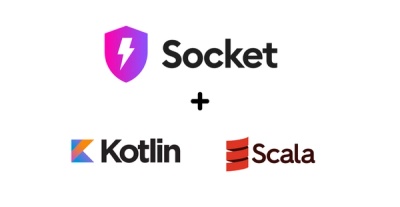
Product
Introducing Scala and Kotlin Support in Socket
Socket now supports Scala and Kotlin, bringing AI-powered threat detection to JVM projects with easy manifest generation and fast, accurate scans.
A lean dependency injection container
This package provides a lean and explicit DI container for code modularization and flexibility in application development.
The main goal of 'sashimono' in it's version 0.1.z was split application development into multiple packages in a coherent way, allowing each piece to be developed and maintained in isolated environments without compromising the whole application and its integration. This meant that the package lived with two responsibilities, that of being a dependency container and that of being a plugin system. And while the initial idea of sashimono was fine, it made the package awkward to use for those who only wanted to use one of those features. So we decided to split the package into two that would fulfill those responsibilities separately. Since version 1.y.zSashimono only responds to the dependency container feature.
For this version we took a bit of inspiration from Bottle, to make the package so small, atomic and dependency-free that you can simply download it to your project folder instead of installing it. Although we will keep both options.
The idea of using a DI container revolves around the Container object and it's the main and only object that Sashimono explicitly provides.
from sashimono import Container
The Container works as a dictionary that binds types and strings with the function that holds how the objects must be build using container itself.
from sashimono import Container
c = Container()
c["number"] = Container.singleton(lambda c: 5)
print(c["number"])
The output must be 5
But how do they work? Sashimono uses the singleton and factory methods to define the construction expressions. Those expressions are executed when you try to access a specific object by building it. In the example above, the expression lambda c:5 is executed when called in print(c['number'])
resulting in 5. The c parameter represents the container itself, so you can perform dependency injection within those build expressions. Because singleton was used, if we try to access c["number"] once again, it will give us the exact same instance that was already generated.
from sashimono import Container
class Foo:
def __init__(number):
self.number = number
c = Container()
c["number"] = Container.singleton(lambda c: 5)
c[Foo] = Container.factory(lambda c: Foo(c["number"]))
print(c[Foo].number)
The output must be 5
In this other example some manual DI was made and the factory method was used so every time you access to Foo through the container it will give you a new instance of Foo. The same can be made relaying on automatic injection as you can see in the next example.
from sashimono import Container
class Foo:
def __init__(number):
self.number = number
c = Container()
c["number"] = Container.singleton(5)
c[Foo] = Container.factory(Foo)
print(c[Foo].number)
The output must be 5
We made a tweak around class inheritance too. When you store a class and ask for it using its parent in the container, if that parent doesn't exist in the container, it'll return the child class that's already stored. Check it out in the next example.
from sashimono import Container
class Foo:
def __init__(number):
self.number = number
class Baa(Foo):
...
c = Container()
c["number"] = Container.singleton(5)
c[Baa] = Container.factory(Baa)
print(c[Foo].number)
The output must be 5
So even if Foo wasn't defined inside the container if you ask for it the container will search a child of Foo, in this case Baa, to return.
That's all.Happy coding! 👋
FAQs
A lean dependency injection container
We found that sashimono demonstrated a healthy version release cadence and project activity because the last version was released less than a year ago. It has 1 open source maintainer collaborating on the project.
Did you know?

Socket for GitHub automatically highlights issues in each pull request and monitors the health of all your open source dependencies. Discover the contents of your packages and block harmful activity before you install or update your dependencies.

Product
Socket now supports Scala and Kotlin, bringing AI-powered threat detection to JVM projects with easy manifest generation and fast, accurate scans.

Application Security
/Security News
Socket CEO Feross Aboukhadijeh and a16z partner Joel de la Garza discuss vibe coding, AI-driven software development, and how the rise of LLMs, despite their risks, still points toward a more secure and innovative future.

Research
/Security News
Threat actors hijacked Toptal’s GitHub org, publishing npm packages with malicious payloads that steal tokens and attempt to wipe victim systems.